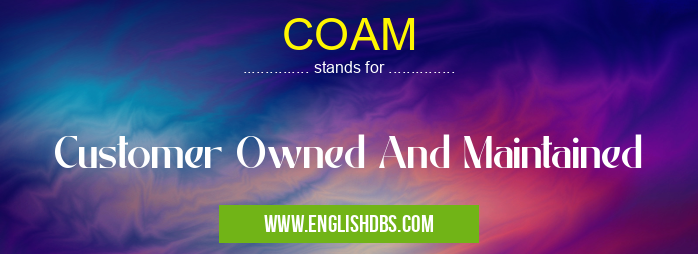What does COAM mean in TELECOM
COAM stands for Customer Owned and Maintained. It refers to equipment or services that are owned, managed and maintained by the customer, as opposed to being owned and maintained by the supplier or vendor. COAM is a popular business model in many industries and has helped drive competition and innovation in many different markets.

COAM meaning in Telecom in Computing
COAM mostly used in an acronym Telecom in Category Computing that means Customer Owned And Maintained
Shorthand: COAM,
Full Form: Customer Owned And Maintained
For more information of "Customer Owned And Maintained", see the section below.
Essential Questions and Answers on Customer Owned And Maintained in "COMPUTING»TELECOM"
What is COAM?
COAM stands for Customer Owned and Maintained. This means that the customer owns, manages, and maintains their own equipment or services rather than relying solely on the supplier or vendor.
Why choose a COAM business model?
A COAM business model can provide customers with more control over their own investments. It also allows companies to save money on maintenance fees by doing it themselves, which makes it an attractive option for many businesses.
Are there any risks associated with a COAM model?
Yes, there are certain risks associated with a COAM business model. For example, if the customer does not properly manage and maintain their own equipment or services then they may experience downtime or performance issues as a result. Additionally, some customers may not have sufficient technical expertise or resources to properly maintain their own systems.
Is a COAM model suitable for all types of businesses?
Not necessarily - it depends largely on the type of technology or services involved as well as the size of the company. For example, smaller companies may find that outsourcing maintenance is a better option than taking on such tasks themselves due to limited resources or expertise. Similarly, larger companies might find that managing their own equipment can be too costly compared to outsourcing maintenance fees.
How can I determine if a COAM model is right for me?
It's important to consider factors such as your company's size and technical expertise before making a decision about whether you should use a COAM model or outsource maintenance fees instead. You should also ensure that you understand all of the responsibilities that come with self-maintaining your equipment before committing to this route.
Final Words:
A Customer Owned And Maintained (COAM) business model can be an attractive option for some businesses looking to gain more control over their investments while potentially saving money on maintenance fees.. However, it's important to consider factors such as company size, technical expertise and responsibility before deciding if this is the right option for you.
